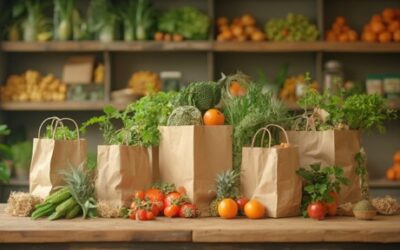
As of 2020, the United States generated approximately 292.4 million tons of waste, with only about 32.1% being recycled or composted. For leaders in the food service sector, it’s crucial to understand your role in this dynamic and explore options for sustainable practices.
One question that often arises is: Can you compost paper plates?
Introduction to Compostability
Compostability refers to an item’s ability to decompose into natural elements within a composting environment, leaving no toxicity in the soil. For a product to be considered truly compostable, it must break down effectively through biological processes. This typically takes place within a commercial composting facility or, in some cases, in home compost bins.
For food service, understanding compostability isn’t just an operational detail; it’s a business imperative. As consumers become more environmentally conscious and more cities and states introduce regulations, companies must pivot towards sustainable solutions that align with public expectations.
What Makes a Product Compostable?
Before addressing paper plates specifically, it’s essential to understand the criteria that determine if a product is compostable. According to ASTM International standards, a product is compostable if it meets the following:
- Biodegradability: The item must break down into carbon dioxide, water, inorganic compounds, and biomass at a consistent rate with known compostable materials.
- Disintegration: After composting, the material should not be visually distinguishable from the rest of the compost.
- Ecotoxicity: The resulting compost should support plant growth, indicating no harmful residues remain.
It gets confusing at times. If a paper plate is compostable then it is also biodegradable. However, if a paper plate is biodegradable, it may not be compostable. Understanding these criteria helps determine whether specific paper plates meet compostability standards.
Can You Compost Paper Plates?
Yes, but only when you choose a compostable paper plate. Not all paper plates are created equal. Some are made purely from paper pulp, while others include coatings or additives designed for durability, grease resistance, or aesthetic purposes. These additional components can impact the plate’s ability to decompose. Selecting the right paper plate is crucial.
Uncoated Paper Plates
Made entirely of paper pulp, these are typically compostable as they break down into organic matter. However, their use in practical scenarios may be limited due to a lack of sturdiness and moisture resistance. Nobody wants a plate that tears or soaks through.
Wax-Coated Paper Plates
Often used for enhanced strength and moisture resistance, wax-coated plates can still be compostable if the coating is plant-based and certified for composting. These are better than uncoated plates.
Plastic-Lined Paper Plates
These pose a challenge as the plastic lining prevents the plate from breaking down in a composting environment, leading it to contribute to landfill waste rather than decomposing.
PLA Lined Paper Plates:
In an effort to reduce plastic waste, alternatives like corn starch lining have emerged as a potential solution. Corn starch lining is an alternative to plastic lining in disposable items meant for hot food or liquid. It is derived from corn, a renewable resource, making it a more sustainable option.
Compostability Certification and Standards
Leaders in food service must ensure their products comply with recognizable standards to assure consumers and stakeholders of their environmental commitment. Certifications such as BPI (Biodegradable Products Institute) indicate that a product meets industry standards for compostability in industrial facilities.
The BPI certification confirms that materials have been tested and validated to disintegrate effectively without leaving toxic residue. This can be a robust indicator when selecting paper plates for your food service operations.
Case Studies: Real-World Applications for Compostable Paper Plates
Several notable companies have successfully implemented compostable solutions:
- Sweetgreen: A salad chain focused on sustainability, Sweetgreen has transitioned to using 100% plant-based, compostable bowls and utensils. They educate customers on proper disposal and work with composting facilities to ensure waste is appropriately processed.
- Chipotle Mexican Grill: Chipotle has made strides in utilizing compostable packaging, including bowls and cutlery, aligning with their broader environmental commitments.
Benefits of Choosing Compostable Paper Plates
Adopting compostable paper plates and other materials offers multiple benefits:
- Environmental Impact: Reducing landfill waste directly supports environmental sustainability goals. Composting helps return valuable nutrients to the earth.
- Brand Differentiation: Demonstrating a commitment to eco-friendly practices can set your brand apart and appeal to increasingly eco-conscious consumers.
- Regulatory Compliance: Staying ahead of potential regulations regarding plastic and waste reduction can prevent future compliance headaches and associated costs.
- Employee and Consumer Morale: Engaging in sustainable practices can boost morale among employees and foster loyalty among customers who share similar values.
- Reducing Plastic Pollution: Choosing compostable means choosing plastic-free, which helps reduce plastic pollution.
Plus, when you choose Emerald Ecovations, you get compostable paper plates made without plastics and without the use of trees to help end deforestation and plastic pollution.
The surprising thing for many people is that the cost for compostable alternatives are getting closer and closer to non-compostable products. We offer a whole range of tree-free, plastic-free, compostable solutions for homes and businesses of all sizes. Going green shouldn’t have to cost more.
Composting Paper Plates
Buying compostable paper plates is one step, composting them is another step altogether. When you buy a compostable paper plate, it will typically be marked as either compostable or commercially compostable.
When you buy home compostable paper plates, you can actually place them in your garden for time, air, and the sun to allow it to disintegrate. You can also place them in your compost can if you have a compost facility. This assumes you didn’t put toxic chemicals on your plate.
When you buy commercially compostable paper plates, you will have to find a commercial composting facility that will take these products. To find your local facility, use Find a Composter.
A Sustainable Future
The journey toward sustainability in food service is ongoing and multifaceted. By understanding the compostability of paper plates and proactively moving towards certified compostable options, you demonstrate leadership in responsible business practices. While challenges exist, the long-term benefits to the environment, brand reputation, and possibly even profitability, make this transition a worthwhile investment.
Can you compost paper plates?
Related Articles
Our Mission and Innovations
Launched in 1997, our mission has been to end deforestation and plastic pollution by providing sustainable solutions for everyday essentials.
How does compost contribute to the sustainability of food production?
As the world moves towards more sustainable practices, composting is becoming a cornerstone in transforming food production. It leverages organic waste management to enrich soil, reduce pollution, and promote the recycling of nutrients. According to the Environmental...
Are Paper Plates Compostable? A Simple Guide
Are paper plates compostable? It depends on the type of paper plates you buy. Emerald Ecovations Tree-Free plates are eco-friendly and commercially compostable.



